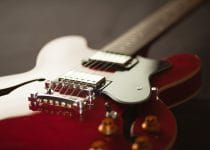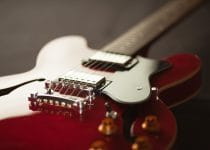Buying Your First Acoustic Guitar (5 Things You MUST Consider) | A Beginner’s Guide
Hey gang, Steve with Guitar Center. Today
we're going to take a look at one of the coolest things you can do in your whole life:
getting your first acoustic guitar. In this video, we'll cover at a high level things
like strings, sizes and shapes, tonewoods, construction techniques and added technology. And when it comes to
choosing your first acoustic guitar, there's no real right or wrong answers; the right guitar
for you is the one that you're stoked to play. So let's get started. Generally, acoustic guitars can
be broken up into two big categories: nylon string and steel string. Nylon string guitars have more
of a classical sound or a Spanish-style sound. And steel string guitars have more of a
"cowboy chords by the campfire" kind of sound.
Often, people may say it's easier to learn on
a nylon string guitar because the strings are softer to the touch. But that's not
necessarily what you want to go for; you want to go for the sound of the guitar
that you like. And when you first start playing your little fingies are going
to hurt no matter which guitar you get, so just focus on the tone. If you're after more of
that classical or Spanish-style tone, go with the nylon string guitar. Or if you're after more of
a folky acoustic tone, go with the steel string guitar. So now let's take a look at some of the
most popular steel string body shapes and sizes.
Acoustic guitars come in a wide variety of
shapes. And generally, the bigger the body, the bigger the sound. And the tone of the smaller
instruments will have more mid-range and more high frequencies, more of a punchy kind of sound. When
choosing the body size for your acoustic guitar, try a few out and see what feels right. You want
a good physical fit and you want a good sound fit. Let's take a look at some of the most popular
sizes.
Generally, when people think of an acoustic guitar, they think of the dreadnought body
shape. This is a design created by Martin Guitar, and this has a pretty good balance of lows,
highs, mids. It's pretty loud overall in general. And this body shape gives you more of the
classic acoustic tone that you've heard on a zillion recordings. And if you want to go
even larger, you could step up to jumbo size. Your first guitar doesn't
have to be a small guitar; it could be a jumbo-sized guitar
like this if it feels right for you.
So if you do want to start
out on a smaller guitar, you could opt for something
like a parlor-sized guitar. Parlor-sized instruments, three-quarter-sized
guitars, half-sized guitars are generally going to have a smaller body, so it's easier to get
your arm over and play. And often they will have shorter scale length so you don't have to reach as
far to get from fret to fret. They'll often have a smaller nut width so you don't have to reach as
far to go from string to string.
Great guitars for smaller players or just a great guitar to
throw in a bag and take on the camping trip. You'll probably also see a lot
of guitars that have a cutaway. When acoustic guitar started getting amplified,
it was less important to have as much air moving in the guitar itself. So you could take a little
bit away. And makes it much easier to reach the higher frets. So if you're interested in doing a
little bit of shredding on your acoustic guitar, look for something that has a cutaway. As much
as the shape of the guitar influences the overall sound, so too does the wood that it's made out of.
Let's take a look at tonewoods. Acoustic guitars are made from a variety of different woods, and
they're called tonewoods because of their unique properties.
Like on this guitar, this Breedlove,
this is a spruce top. Spruce is a very popular top wood because of its snappy response. The top will
actually flex while you're playing, helping to project the tone, and in this case reproduce some
higher frequencies. This one, for example, with the back and sides being mahogany, would have that
punchy, mid-range sound. Mahogany you can tell by the short grains, rosewood you can see here by
a much longer grain. Oftentimes, maple will have like a flame to it. Maple would be very bright,
rosewood would be referred to as very full, mahogany would be referred to as punchy.
So different woods are used for the neck, or the fingerboard, and those are
often because of their strength. Now on this one, the fingerboard is ebony, very
popular tonewood for the fingerboard. Often, fingerboards are finished in ebony, rosewood or
maple, and based on their frequency response, that adds a little extra snap, or a little
extra warmth to the tone of the guitar overall. These days, tonewoods are sourced worldwide and
companies like Breedlove and very many guitar builders are working to avoid clear-cut forests
and find sustainable ways to produce instruments. For example, this Taylor; this is a Grand Theater.
The back and sides are what's known as Urban Ash, and it's actually created from trees that would
have been in a local park or on the side of the highway.
When those trees are taken down, they
used to be thrown away, and now they're being repurposed into guitars. And they sound great.
If you're looking for something a little less traditional, you can go for an exotic wood. For
example, this one is cocobolo. This is the natural figuring of just growth. Still reproduces a very
great tone overall, but has a much more stunning look. Ultimately, what a guitar comes down to is
the sum of its parts. And we could spend all day sort of specking out what a wood might sound like,
but ultimately you just have to try the guitars out. See how they feel to you; when you hear a
sound that's pleasing to you, that's your guitar. Outside of the wood itself, the construction
techniques that are used to build a guitar influence the tone as well.
These can be factors
like the glue that's used to hold it together, the bracing that's on the inside of the guitar,
the overall construction of the wood itself. For example, some guitars can be a solid wood, which
is just cut down, dried turned into a guitar. Or they could be what's known as a laminate, which
is essentially thinner layers of wood with glue compressed and then held together. This Martin,
for example, has a solid spruce top. The back and sides are HPL or "high pressure laminate." Though
a solid wood is a more premium material, laminate does have some benefits, and that is: it's less
susceptible to those changes in the environment like humidity or temperature. So if you're looking
for an instrument that you can throw in your car, take out to the beach and not have to worry about
it being sensitive to the weather, then a laminate would be the way to go.
A healthy compromise
would be an instrument like this, with a solid wood top and a laminate back and sides. That way
you still get the responsiveness and the resonance from a solid wood top with the added durability
of the laminate back and sides. To build new instruments that have the same sort of tone and
character of a well-seasoned vintage instrument, manufacturers will treat the wood with a process
called torrefaction.
This mimics the effects that time and temperature and humidity have had on a
vintage instrument in one you can buy that was built today. Another factor influencing the tone
of an acoustic is what's going on on the inside. Underneath of the top here, there are pieces of
wood known as bracing. The bracing is here to help support the top. It also helps shape the
tone and the responsiveness of the top itself. Traditionally, the bracing is an X shape, but
builders are always experimenting with different shapes and weights, so it's really going to
come down to the individual instrument that you're trying out.
Ultimately, the sound of your
acoustic guitar is going to be the sum of all of these factors. What is the type of wood? What is
the type of construction? How does the top connect to the back connect to the neck connect to the
fingerboard? And how do they all play together? Going beyond simply the acoustic tone of the
instrument, you can get what's known as an acoustic-electric guitar. These instruments have
built-in electronics so you can amplify the tone. As you can see here, you just use a
regular quarter-inch guitar cable. You can plug into an amp, a recording console.
That way, you wouldn't have to use a microphone to get the acoustic sound; it will be coming from
within. Acoustic guitars can be amplified through transducer pickups.
Oftentimes, they'll
sit underneath the saddle here. The transducer will pick up the vibration of the
instrument and translate that into a sound. Or sometimes, there are sensors on the top, and
sometimes there are even microphones built in. Most acoustic-electrics have a preamp, which gives
you a way to control the tone before it goes out to your amp or to your recording console. In this
case, this has a bass and treble control and a master volume. And often, acoustic-electric
guitars will have a tuner built in. This will mute your output so that way you can
make sure your strings are on the right notes, and not everybody has to hear you tuning in
between songs. Some guitars even have the effects built right in. For example, this Yamaha
Transacoustic produces the reverb and chorus effects right out of the instrument itself, so
you don't even have to plug it in. You still get to hear those sounds in the room while you're
playing. So those are just some of the main things to think about when choosing your first guitar.
We
hope these tools help you navigate your selection process. And come in, try a bunch of guitars out,
have fun. The only right answer is a guitar that you're stoked to play. Is that green? Green
on both sides? It's in tune! Hey! Let's get, let's go to tonewood talk town talk tone
town. Don't worry about your little fingies..


